Marquette Law School poll: Gov. Walker job approval rating at 37%, a new low
Marquette Law School poll: Governor Scott Walker job approval rating at 37%
Marquette Law School poll: Governor Scott Walker job approval rating at 37%
MILWAUKEE — Gov. Scott Walker's job approval rating has sunk a new low of 37 percent, according to a Marquette Law School Poll released Wednesday.
The poll, the first one conducted after Walker quit the presidential race last week, showed that 59 percent of respondents disapproved of his work as governor. Sixty-two percent of those polled said he should not run for a third term.
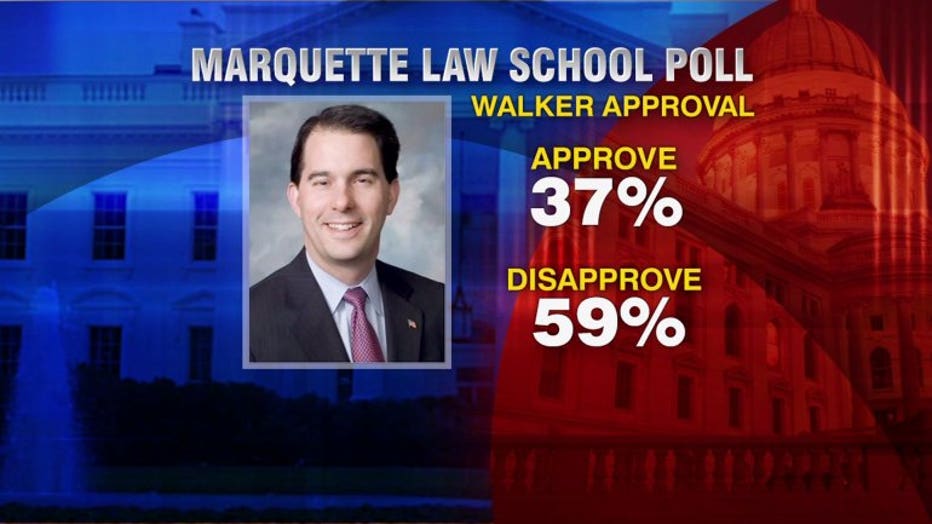
Marquette Law School poll: Governor Scott Walker job approval rating at 37%
Walker's office issued a statement that didn't respond to the poor poll numbers. Instead, a Walker spokeswoman said the governor would be working hard for Wisconsin.
In another blow to the governor, many supporters of his failed presidential campaign said they had shifted their support to Donald Trump. Walker on Sept. 21 said he was quitting the race -- and calling on other candidates to do the same -- in the hopes of another Republican defeating Trump.
Instead, 22 percent of Walker's supporters moved to Trump's camp, enough to vault Trump into first place among Wisconsin Republican primary voters.
"Ironically, he`s provided a reservoir of additional support for Trump," said Charles Franklin, director of the MU Law poll.
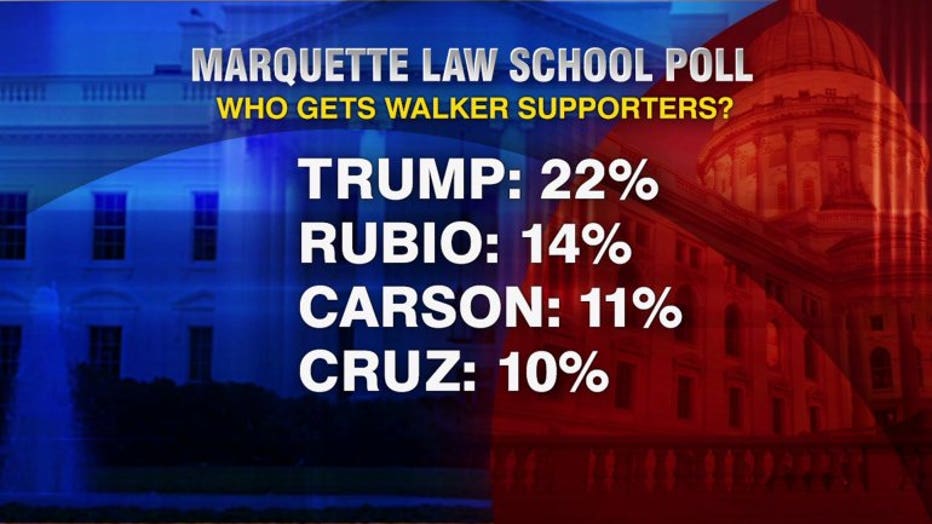
Only 35 percent of those polled said Walker should run for a third term as governor. Support among Republicans for a third-term bid was 79 percent, still lower than the near-unanimous backing he received from GOP voters in previous elections.
Walker has said he hasn't decided whether to run for a third term as governor.
Independent voters have abandoned Walker as the governor shifted to the right during the presidential campaign. The contentious state budget may have also played a role, Franklin said.
"The question I think is more one of whether he can reassemble the public support he had," Franklin said, noting that independent voters carried Walker to each of his gubernatorial victories.
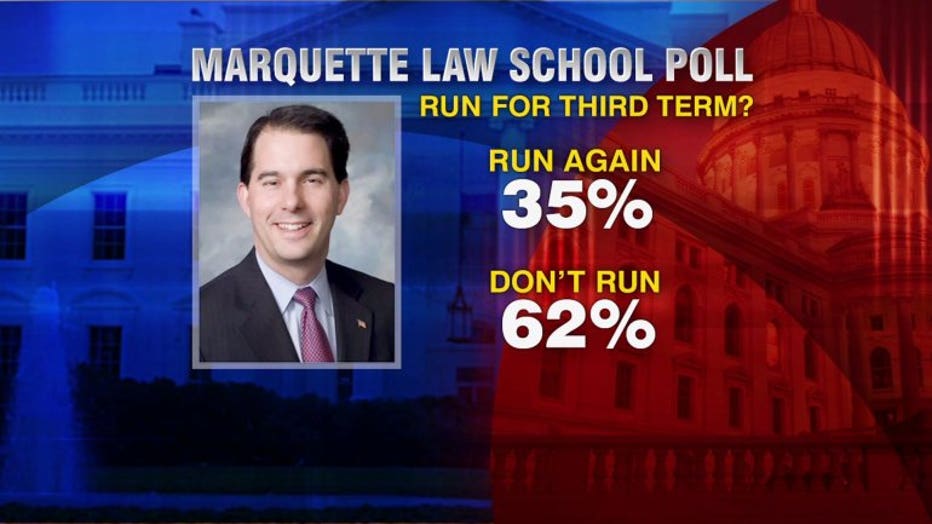
MU Poll: Should Gov. Walker run for third term?
In the GOP presidential race, Trump leads in Wisconsin with 20 percent. Ben Carson is second with 16 percent, then Marco Rubio at 14 percent and Carly Fiorina at 11 percent.
The remainder of the field includes Jeb Bush at 7 percent, Ted Cruz and Rand Paul each at 5 percent, and Mike Huckabee, Chris Christie and John Kasich each at 3 percent. No other candidate received more than 1 percent support.
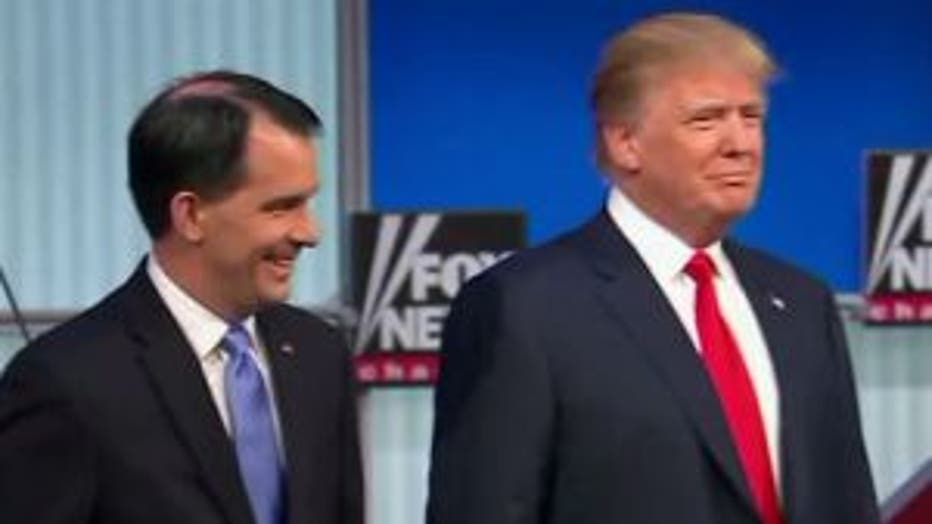
Scott Walker and Donald Trump at first GOP presidential debate
Trump shows a significant gain from August when he was supported by just 9 percent of Wisconsin Republicans.
On the Democratic side, Hillary Clinton has opened a slightly wider leader over Bernie Sanders. Clinton got 42 percent, while Sanders had 30 percent and Joe Biden had 17 percent. No other candidate received more than 1 percent support.
In August, Clinton was at 44 percent, Sanders at 32 percent and Biden at 12 percent and the rest below 1 percent.
In Wisconsin's U.S. Senate race, the poll results continued to swing wildly. Democrat Russ Feingold led Republican Sen. Ron Johnson, 50-36 percent.
In August, the race was tighter, with Feingold at 47 percent to Johnson’s 42 percent. In April, Feingold received 54 percent to Johnson’s 38 percent.
The candidates, despite one being an incumbent senator and the other having been in the U.S. Senate for 18 years, remain relatively unknown to voters. Only 55 percent of voters said they had an opinion of both men.
"That just means that lots of voters are not focused much on the race," Franklin said.
Both Johnson and Feingold's favorability have declined. Feingold is seen favorably by 42 percent of those polled, while 32 percent see him unfavorably.
Johnson's favorability is 27 percent, while 36 percent view him in an unfavorable light.
Johnson's campaign dismissed the poll results.
"The wild swings in these early polls show just how meaningless they are," said Brian Reisinger, a campaign spokesman.
The poll was conducted from Sept. 24 to 28 and included 803 registered voters interviewed by cell phone and by landline, with a margin of error of +/-4.1 percentage points. The poll included slightly more respondents than normal who identified themselves as Democrats or who lean Democrat.
Looking ahead to possible general election preferences of Wisconsin voters, the poll found these results in head-to-head match-ups:
Full breakdown of the results:
Among Republicans, 79 percent would like Walker to run again for governor. Support for a third term is 65 percent among independents who lean Republican, while 15 percent of independents with no party leaning support a third-term bid. Support for a third term among independents who lean Democratic is 9 percent and among Democrats is 6 percent.
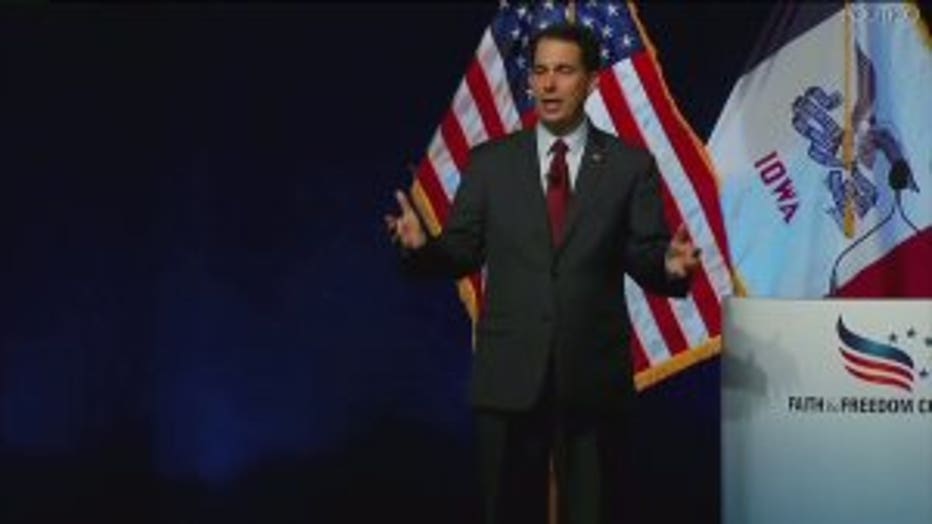
Governor Scott Walker
Asked if they would have supported Walker had he stayed in the Republican presidential race, 28 percent of Republicans and independents who lean Republican say they would, while 55 percent say they would have voted for some other Republican candidate. Ten percent say they would not have voted, five percent say they didn’t know and 2 percent say they would have voted in the Democratic primary. In August, Walker’s presidential bid was backed by 25 percent of GOP voters, down from 40 percent in April.
Among Republicans, 25 percent say they were pleased Walker ran and wish he had stayed in the race, while 40 percent say they were pleased but it was time to get out. Thirty percent say they wish he had not run. Support for the presidential bid is lower among independents who lean Republican, with 10 percent pleased and wishing he stayed in, 35 percent pleased but saying it was time to get out, and 51 percent saying they wish he had not run. Among independents with no party leaning, 67 percent wish he had not run, while 77 percent of Democratic leaners and 79 percent of Democrats wish Walker had not run for president.
Currently, 38 percent see Walker as very conservative, up from 31 percent in October 2014. Thirty-five percent see him as conservative, down from 42 percent in 2014. Seven percent see him as moderate, compared to 10 percent in 2014, and 10 percent see him as liberal or very liberal, the same as in 2014. Nine percent now say they don’t know where to place him ideologically, compared to 6 percent in 2014.
Economic conditions
Over the past year, perceptions of the economy’s direction have become somewhat less positive. Currently 24 percent say the economy has gotten better in the last year, 27 percent say it has worsened, and 47 percent say it has stayed about the same. In September 2014, 30 percent said the economy had improved over the year, 29 percent said it had worsened, and 41 percent said it had stayed about the same.
Looking ahead, 25 percent expect the economy to improve over the next 12 months, 20 percent expect it to worsen, and 50 percent think it will stay about the same. A year ago, 34 percent expected improvement, 17 percent expected worsening, and 44 percent expected little change.
Views of Pope Francis
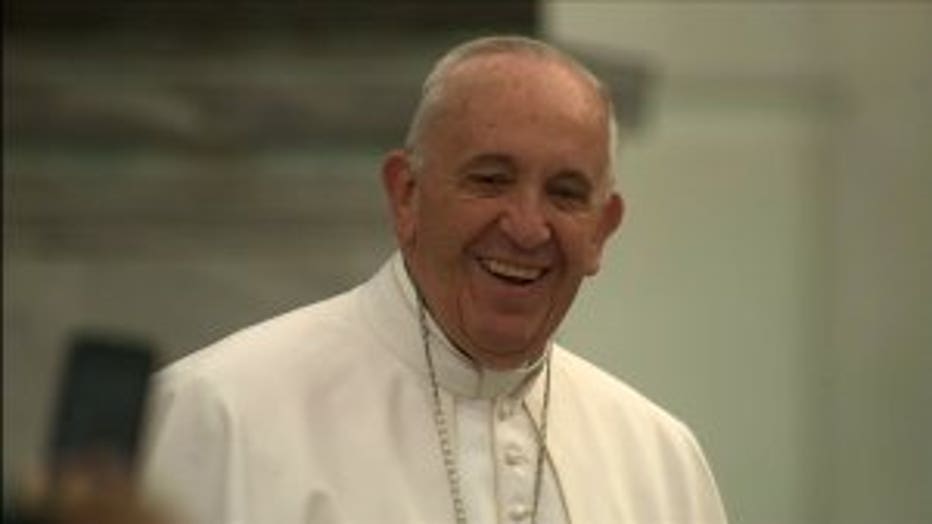
Pope Francis gives a speech on religious freedom at Independence Hall.
Favorable views of Pope Francis have increased. His favorable ratings have risen to 66 percent, from 51 percent in August, with 12 percent holding unfavorable views of him in both months. Those unable to give a rating fall to 21 percent from 36 percent in August. Favorable ratings have increased 5 points among Catholics, to 75 percent from 70 percent. Among Protestants, the increase is 21 points, to 59 from 38 percent. Those who say they have no religious affiliation report a 16 percent increase in favorability, to 71 percent from 55 percent.
Second choices
Combining first and second choices is an alternative measure of a candidate’s strength. The table below provides the first, second, and combined support of all Republican candidates among Republicans and independents who lean Republican. The table is ordered by combined support and then by name. By this measure, Rubio ranks first, followed by Carson, Fiorina and Trump.
| Candidate | First Choice | Second Choice | Combined |
| Rubio | 14 | 17 | 31 |
| Carson | 16 | 12 | 28 |
| Fiorina | 11 | 15 | 26 |
| Trump | 20 | 5 | 25 |
| Bush | 7 | 10 | 17 |
| Cruz | 5 | 8 | 13 |
| Christie | 3 | 7 | 10 |
| Huckabee | 3 | 6 | 9 |
| Paul | 5 | 4 | 9 |
| Kasich | 3 | 1 | 4 |
| Jindal | 1 | 2 | 3 |
| Santorum | 1 | 2 | 3 |
| Graham | 0 | 2 | 2 |
| Pataki | 0 | 1 | 1 |
| Gilmore | 0 | 0 | 0 |
Among the Democrats, Clinton ranks first in combined support, and Biden moves to second place, with Sanders in third.
| Candidate | First Choice | Second Choice | Combined |
| Clinton | 42 | 27 | 69 |
| Biden | 17 | 38 | 55 |
| Sanders | 30 | 21 | 51 |
| O'Malley | 1 | 3 | 4 |
| Chafee | 0 | 3 | 3 |
| Webb | 0 | 2 | 2 |
Opinions of other political figures
Approval of how President Barack Obama is handling his job stands at 51 percent, with 45 percent disapproving. In August, 48 percent approved and 48 percent disapproved.
Lt. Gov. Rebecca Kleefisch is rated favorably by 21 percent of registered voters and unfavorably by 29 percent, with 49 percent unable to give a rating. In October 2014, she received a 29 percent favorable and 25 percent unfavorable rating, with 45 percent unable to give a rating.
About the Marquette Law School Poll
The Marquette Law School Poll is the most extensive statewide polling project in Wisconsin history. This poll interviewed 803 registered Wisconsin voters, by both landline and cell phone, from September 24-28, 2015. The margin of error is +/- 4.1 percentage points for the full sample. For Republicans and independents who lean toward the Republican Party, the sample size is 321, with a margin of error of +/- 6.5 percentage points. For Democrats and independents who lean toward the Democratic Party, the sample size is 394, with a margin of error of +/-5.9 percentage points. Republican and Democratic presidential primary items were asked of the corresponding party samples.
The partisan makeup of this sample, including those who lean to a party, is 40 percent Republican, 49 percent Democratic and 9 percent independent. The long-term estimate over the previous 29 statewide Marquette polls, with 25,121 respondents, is 43 percent Republican and 47 percent Democratic, with 9 percent independent. The partisan makeup excluding those who lean to a party is 25 percent Republican, 30 percent Democratic and 41 percent independent, compared to the long-term estimate of 27 percent Republican, 31 percent Democratic and 38 percent independent.
The entire questionnaire, full results, and breakdowns by demographic groups are available at http://law.marquette.edu/poll.

